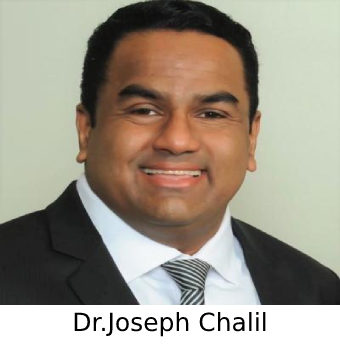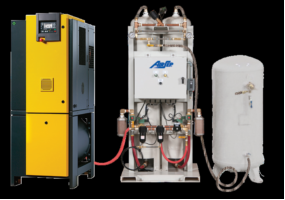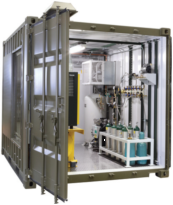The problem is not a shortage of medical oxygen but the supply chain of delivering it to the patient bedside in a hospital. A routine site at all major Indian hospitals is the large oxygen cylinders delivering oxygen to patients at the bedside, says Dr. Joseph Chalil.
International media is filled with headlines such as “Indian COVID-19 Patients Die as Ventilators Run Out of Oxygen” and showing images of people with empty oxygen cylinders crowding refilling facilities in Uttar Pradesh for their relatives in hospitals. The last such news was from Pakistan in December 2020 when six COVID-19 patients died in Khyber teaching hospital in Peshawar.
 India has a daily production capacity of at least 7,100 tons of oxygen, including for industrial use, which appears to be more than enough to meet current demand. The problem is not a shortage of medical oxygen but the supply chain of delivering it to the patient bedside in a hospital. A routine site at all major Indian hospitals is the large oxygen cylinders delivering oxygen to patients at the bedside. Yet this is something you never see in a western hospital. All American hospitals have central piping, which delivers oxygen to the patient bedside from a Pressure Swing Adsorption (PSA) Oxygen Plant attached to each hospital. This is one of the building permit requirements for a new hospital in the USA. Medical oxygen can easily be manufactured from surrounding air.
India has a daily production capacity of at least 7,100 tons of oxygen, including for industrial use, which appears to be more than enough to meet current demand. The problem is not a shortage of medical oxygen but the supply chain of delivering it to the patient bedside in a hospital. A routine site at all major Indian hospitals is the large oxygen cylinders delivering oxygen to patients at the bedside. Yet this is something you never see in a western hospital. All American hospitals have central piping, which delivers oxygen to the patient bedside from a Pressure Swing Adsorption (PSA) Oxygen Plant attached to each hospital. This is one of the building permit requirements for a new hospital in the USA. Medical oxygen can easily be manufactured from surrounding air.
Among the most significant challenges early in the COVID-19 Pandemic was the shortage of essential supplies like personal protective equipment (PPE) and ventilators. These products are tied to supply chains that stretch worldwide, and the Pandemic highlighted their fragility and susceptibility to significant disruptions. As China, a leading global exporter, dealt with the Pandemic in its early days, it was forced to shut down manufacturing, leaving the rest of the world scrambling to address its rapidly shifting supply needs.
Prime Minister Narendra Modi has also given a call for self-reliance – an ‘Aatmanirbhar Bharat’ where he talks of integrating India with the world moving away from isolation but from a position of internal strength. The aim is to make India and its citizens independent and self-reliant in all senses. Mr. Modi further outlined five pillars of Aatma Nirbhar Bharat – Economy, Infrastructure, System, Vibrant Demography, and Demand. India demonstrated its ability to go from producing zero PPE kits pre- COVID to producing millions of kits and exporting them today as a result of the COVID-19 Pandemic. Let us also make our hospitals self-reliant in Medical Oxygen production.
A vision for the future of health-conscious manufacturing
A supply chain that depends on domestic manufacturing is part of our strategic healthcare plan for the future. In the book *Beyond the COVID-19 Pandemic*, we outline a 33-33-33 Buy Local Policy, which involves increased purchases of local products while allowing purchasers flexibility to tap into the global marketplace. In the plan, healthcare systems would be required to buy 33% of their products locally within their region, 33% of their products within the country, and 33% from outside. This policy aims to create a flexible supply chain that could be ramped up to deal with emergencies.
Self-reliance has always been an Indian (The Swadeshi Movement) virtue and the key to India’s success and development. Suppose one supply chain is cut off due to war, natural disaster, or bioterrorism; there are other options to maintain and sustain supply chains. This will also ensure that the dependency on one particular source for anything essential is minimized. Domestic manufacturing is vital for job creation and a strong economy, and it’s also essential for national security.
 AirSep Corporation of New York has installed PSA Medical Oxygen Systems in more than 4,500 hospitals in nearly 50 countries worldwide, including several hospitals in India, to meet their central pipeline and other oxygen needs. These generators and plants operate automatically to supply patient, surgical, and critical care units in medical facilities, military field hospitals, on-site emergency preparedness centers, and disaster-relief efforts. There are several other manufacturers with similar technologies.
AirSep Corporation of New York has installed PSA Medical Oxygen Systems in more than 4,500 hospitals in nearly 50 countries worldwide, including several hospitals in India, to meet their central pipeline and other oxygen needs. These generators and plants operate automatically to supply patient, surgical, and critical care units in medical facilities, military field hospitals, on-site emergency preparedness centers, and disaster-relief efforts. There are several other manufacturers with similar technologies.
Supply chain policy does not have to be an all-or-nothing proposition. That is to say, we should neither import everything nor should we import nothing. Currently, however, we are too reliant on imports in some areas, which hurt us during the early days of this Pandemic. More steps must be taken to create reserves of supplies and manufacturing capacity, similar to the U.S. strategic oil reserves or the Indian strategic food reserves.
India should invest in mobile containerized, turnkey packaged oxygen systems that are ideal for locations where a compressed air supply is limited or unavailable. These units can be truck mounted and moved to areas of shortage or pandemic hot spots. Containerized units can also be used for military applications as well. The oxygen generator within a containerized unit produces oxygen from an air compressor that is included in the package. These rugged systems can perform in extreme temperatures, high humidity conditions, and at high elevations.
 Let this be the Last Medical Oxygen Crisis in India. Let us not scramble our resources; purchasing compressed liquid oxygen from Russia or China, which at best is a temporary fix but will arrive too late for our patients’ bedside in Delhi. Let us retrofit our hospitals with central oxygen piping
Let this be the Last Medical Oxygen Crisis in India. Let us not scramble our resources; purchasing compressed liquid oxygen from Russia or China, which at best is a temporary fix but will arrive too late for our patients’ bedside in Delhi. Let us retrofit our hospitals with central oxygen piping
and support installing hospital oxygen plants and backup systems. Domestic production policies of all medical supplies will lead to job creation and positively impact the environment, reducing the distance oxygen and other supplies must travel from manufacturer to end-user. Local production is also a necessary part of national defense in a world where bioterrorism is an ever-present possibility—the military, for its part, has demonstrated the importance of not centralizing any aspect of its supply chain to one region or country.
India can lead the way globally by building supply chains that incorporate local manufacturing that can be ramped up to address critical needs. This goal recognizes that global supply chains can be broken, and alternatives need to be in place. When countries take these lessons and models to heart and use them to craft policy, their citizens can benefit from a common-sense approach that empowers us to mitigate challenges—everything from a natural disaster or political upheaval to a once-in-a-100-year pandemic.
(Prof. (Dr.) Joseph M. Chalil is an Adjunct Professor & Chair of the Complex Health Systems advisory board at Nova Southeastern University’s School of Business; Chairman of the Indo-American Press Club, and The Universal News Network publisher. He recently published a Best Seller Book – “Beyond the COVID-19 Pandemic: Envisioning a Better World by Transforming the Future of Healthcare.”)
